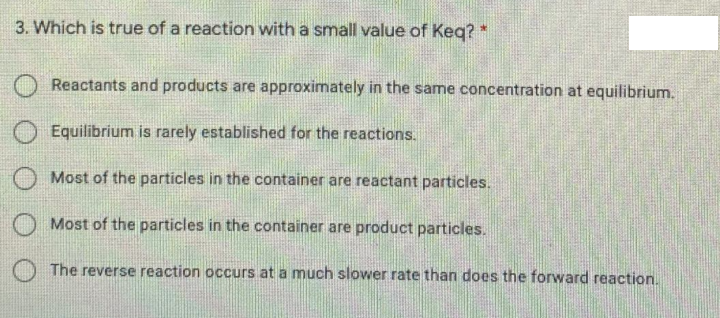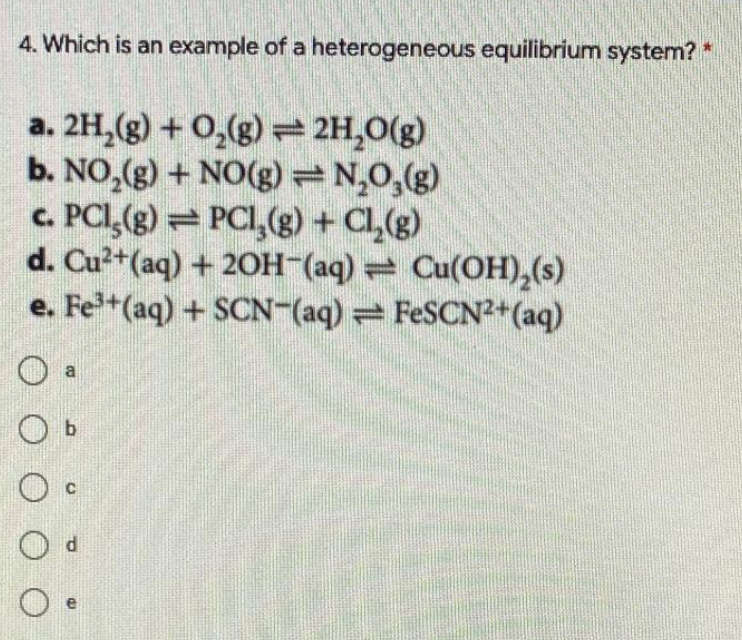3. Which is true of a reaction with a small value of Keq? * Reactants and products are approximately in the same concentration at equilibrium. Equilibrium is rarely established for the reactions. O Most of the particles in the container are reactant particles. O Most of the particles in the container are product particles. The reverse reaction occurs at a much slower rate than does the forward reaction.
3. Which is true of a reaction with a small value of Keq? * Reactants and products are approximately in the same concentration at equilibrium. Equilibrium is rarely established for the reactions. O Most of the particles in the container are reactant particles. O Most of the particles in the container are product particles. The reverse reaction occurs at a much slower rate than does the forward reaction.
Chemistry: Matter and Change
1st Edition
ISBN:9780078746376
Author:Dinah Zike, Laurel Dingrando, Nicholas Hainen, Cheryl Wistrom
Publisher:Dinah Zike, Laurel Dingrando, Nicholas Hainen, Cheryl Wistrom
Chapter18: Acids And Bases
Section: Chapter Questions
Problem 8STP
Related questions
Question

Transcribed Image Text:3. Which is true of a reaction with a small value of Keq? *
O Reactants and products are approximately in the same concentration at equilibrium.
Equilibrium is rarely established for the reactions.
O Most of the particles in the container are reactant particles.
Most of the particles in the container are product particles.
The reverse reaction occurs at a much slower rate than does the forward reaction.

Transcribed Image Text:4. Which is an example of a heterogeneous equilibrium system? *
a. 2H,(g) + 0,(g) 2H,0(g)
b. NO,(g) + NO(g) N,0,(g)
c. PCI,(g) PCI,(g) + Cl,(g)
d. Cu²+(aq) + 20H (aq) = Cu(OH),(s)
e. Fe+(aq) + SCN-(aq) FESCN2+(aq)
a
O b
Expert Solution
This question has been solved!
Explore an expertly crafted, step-by-step solution for a thorough understanding of key concepts.
This is a popular solution!
Trending now
This is a popular solution!
Step by step
Solved in 2 steps with 2 images

Knowledge Booster
Learn more about
Need a deep-dive on the concept behind this application? Look no further. Learn more about this topic, chemistry and related others by exploring similar questions and additional content below.Recommended textbooks for you

Chemistry: Matter and Change
Chemistry
ISBN:
9780078746376
Author:
Dinah Zike, Laurel Dingrando, Nicholas Hainen, Cheryl Wistrom
Publisher:
Glencoe/McGraw-Hill School Pub Co

World of Chemistry, 3rd edition
Chemistry
ISBN:
9781133109655
Author:
Steven S. Zumdahl, Susan L. Zumdahl, Donald J. DeCoste
Publisher:
Brooks / Cole / Cengage Learning

Introductory Chemistry: A Foundation
Chemistry
ISBN:
9781337399425
Author:
Steven S. Zumdahl, Donald J. DeCoste
Publisher:
Cengage Learning

Chemistry: Matter and Change
Chemistry
ISBN:
9780078746376
Author:
Dinah Zike, Laurel Dingrando, Nicholas Hainen, Cheryl Wistrom
Publisher:
Glencoe/McGraw-Hill School Pub Co

World of Chemistry, 3rd edition
Chemistry
ISBN:
9781133109655
Author:
Steven S. Zumdahl, Susan L. Zumdahl, Donald J. DeCoste
Publisher:
Brooks / Cole / Cengage Learning

Introductory Chemistry: A Foundation
Chemistry
ISBN:
9781337399425
Author:
Steven S. Zumdahl, Donald J. DeCoste
Publisher:
Cengage Learning

Chemistry for Engineering Students
Chemistry
ISBN:
9781337398909
Author:
Lawrence S. Brown, Tom Holme
Publisher:
Cengage Learning


Chemistry: An Atoms First Approach
Chemistry
ISBN:
9781305079243
Author:
Steven S. Zumdahl, Susan A. Zumdahl
Publisher:
Cengage Learning